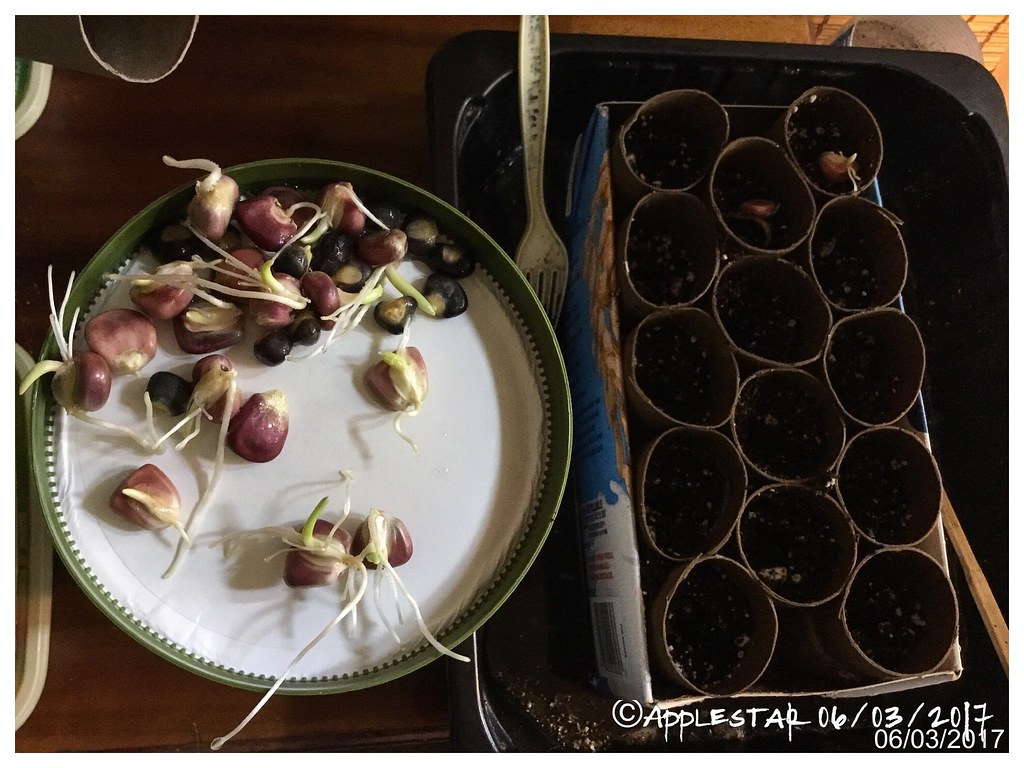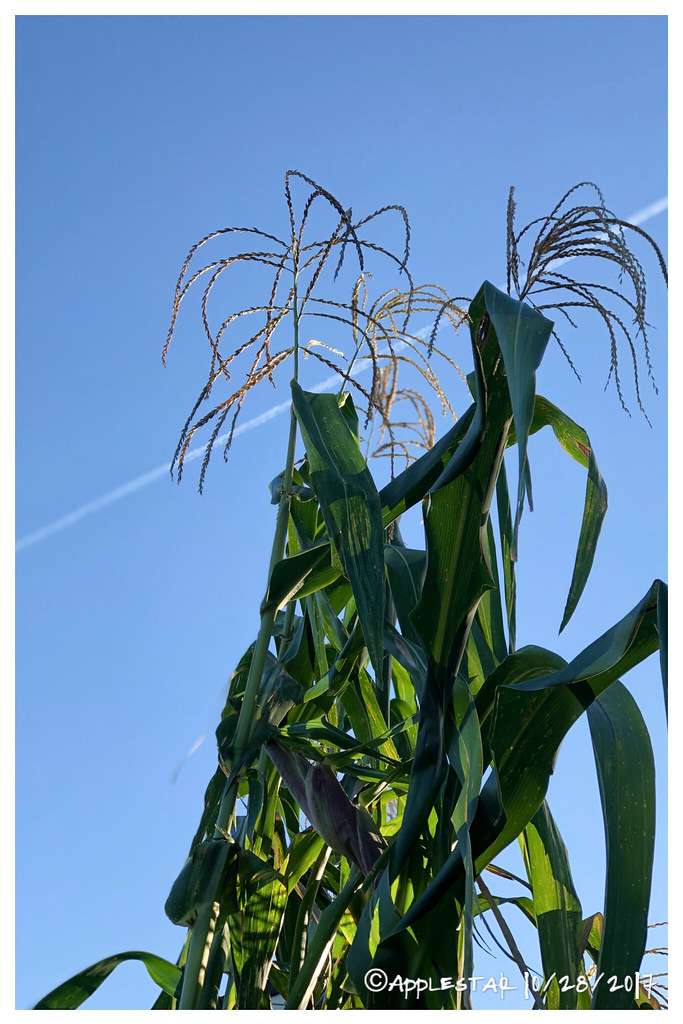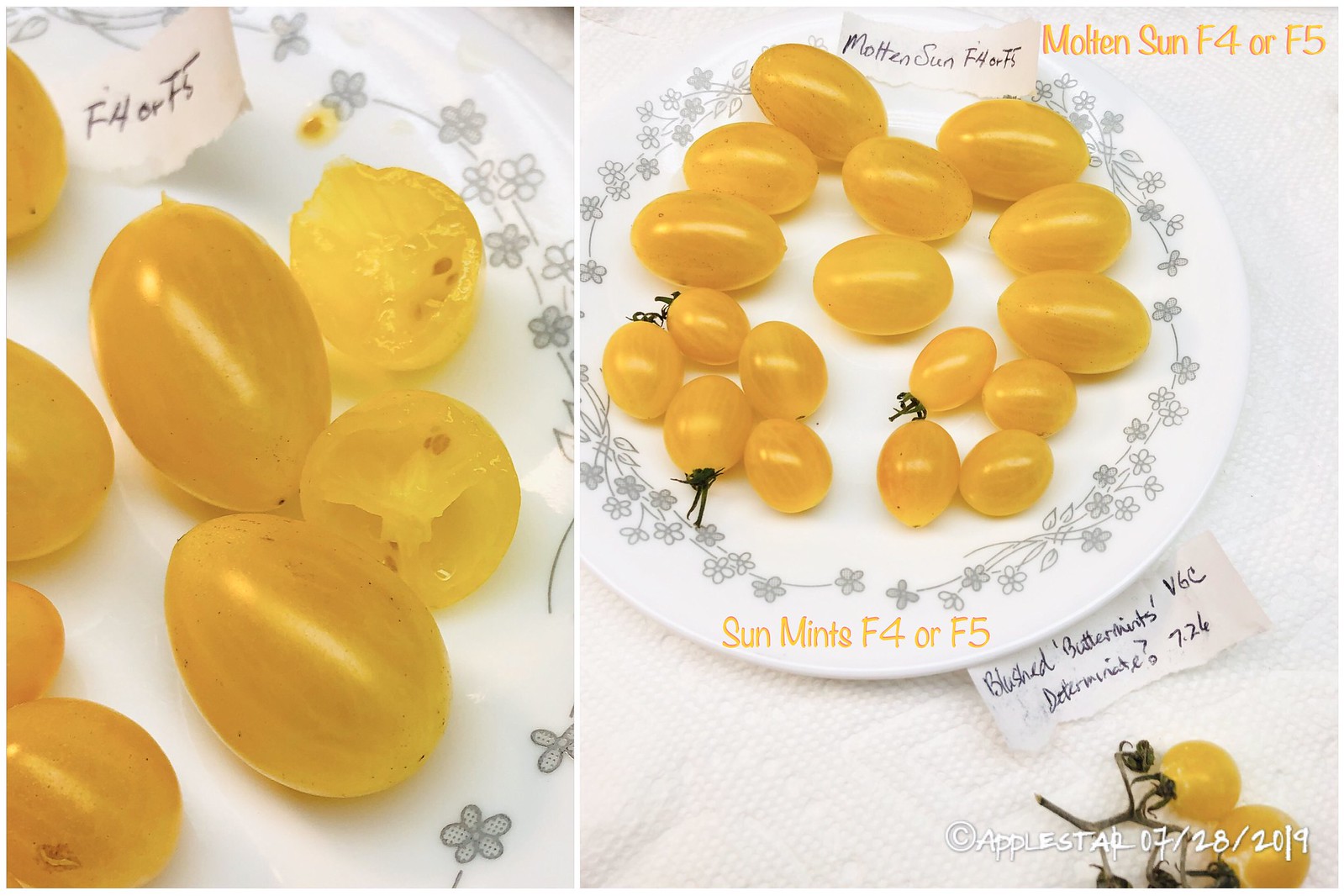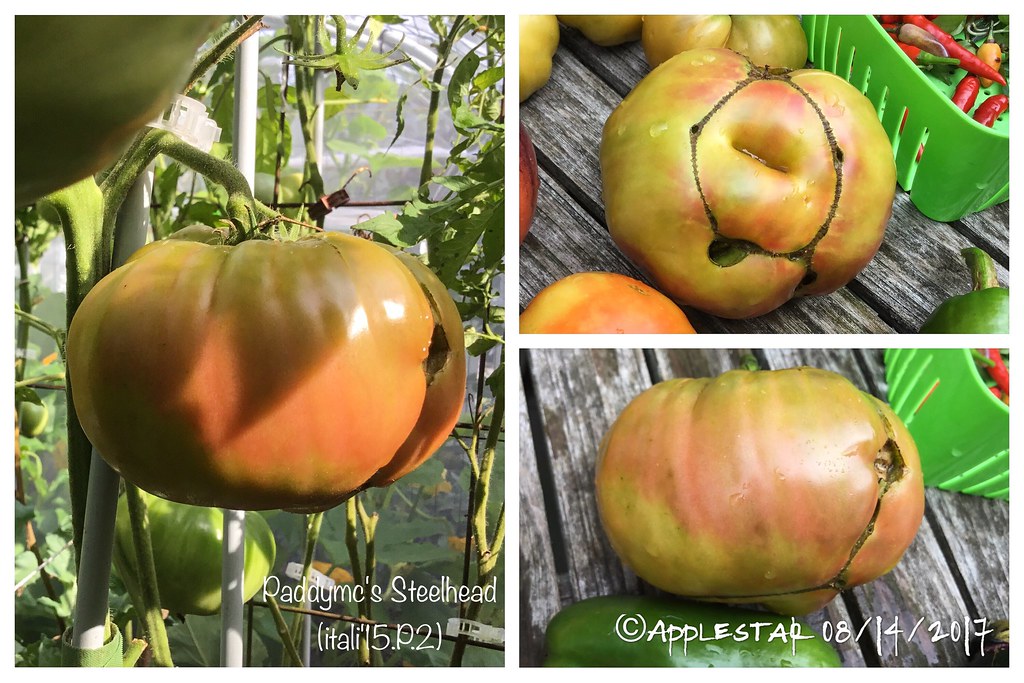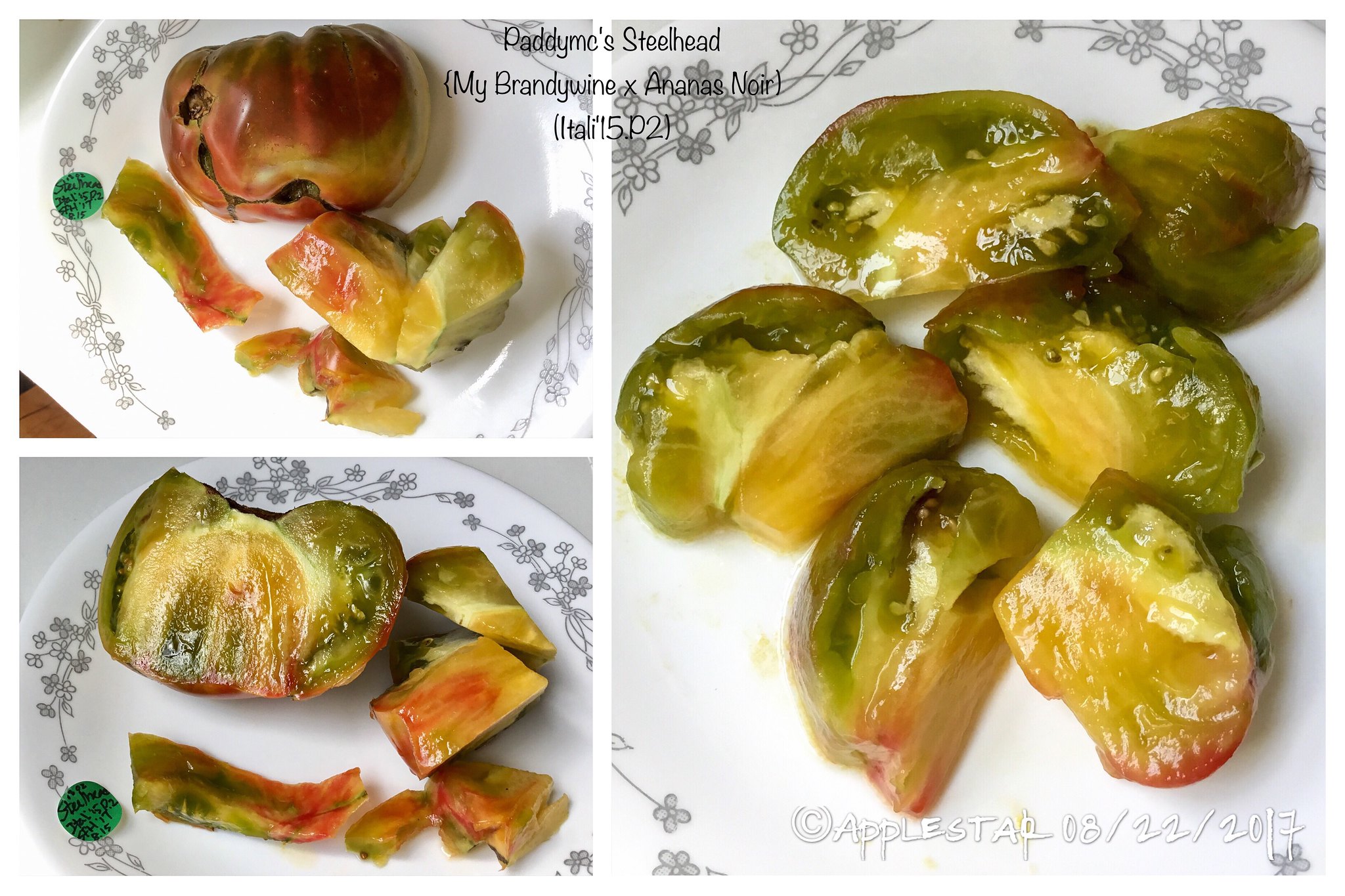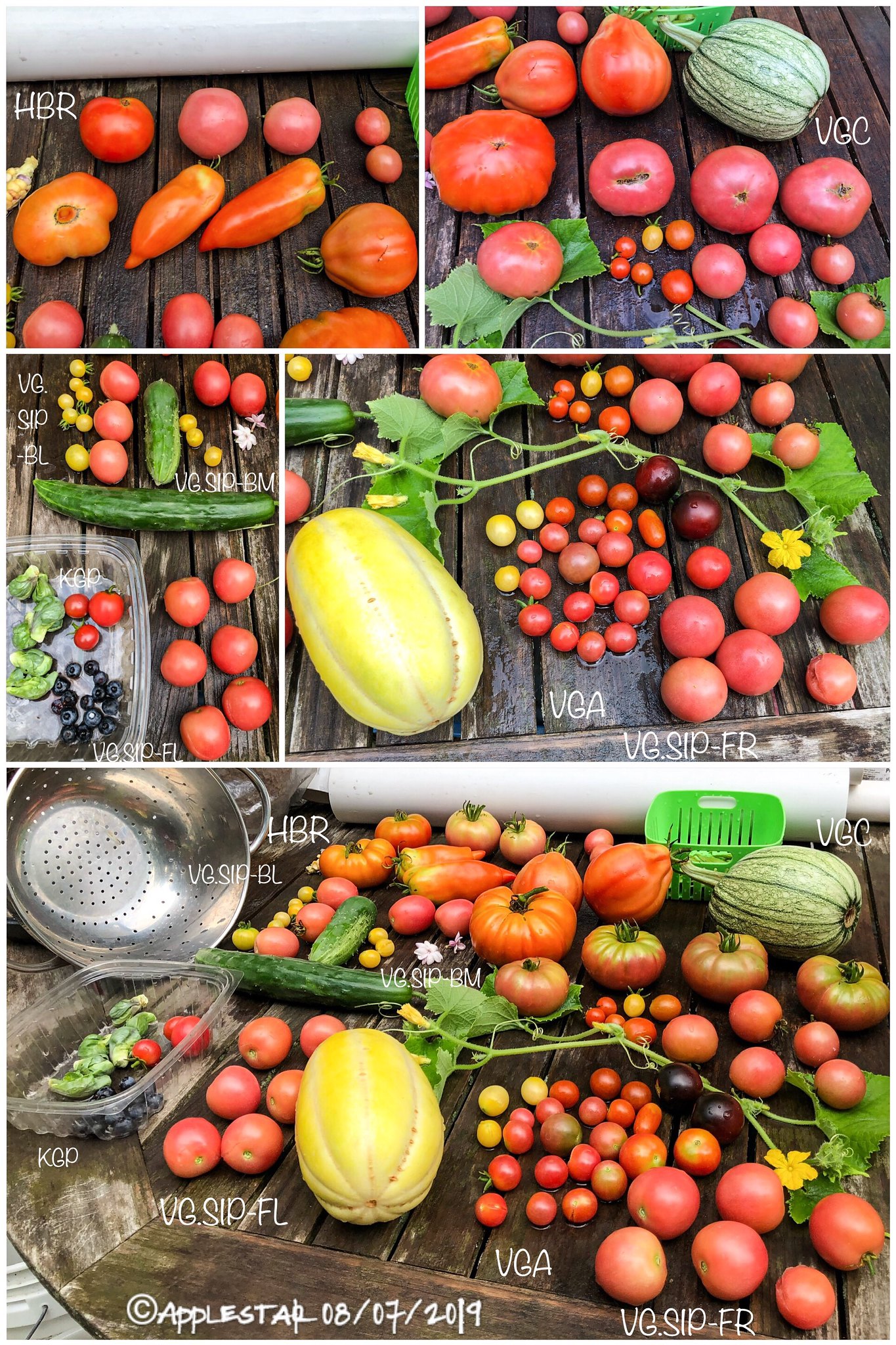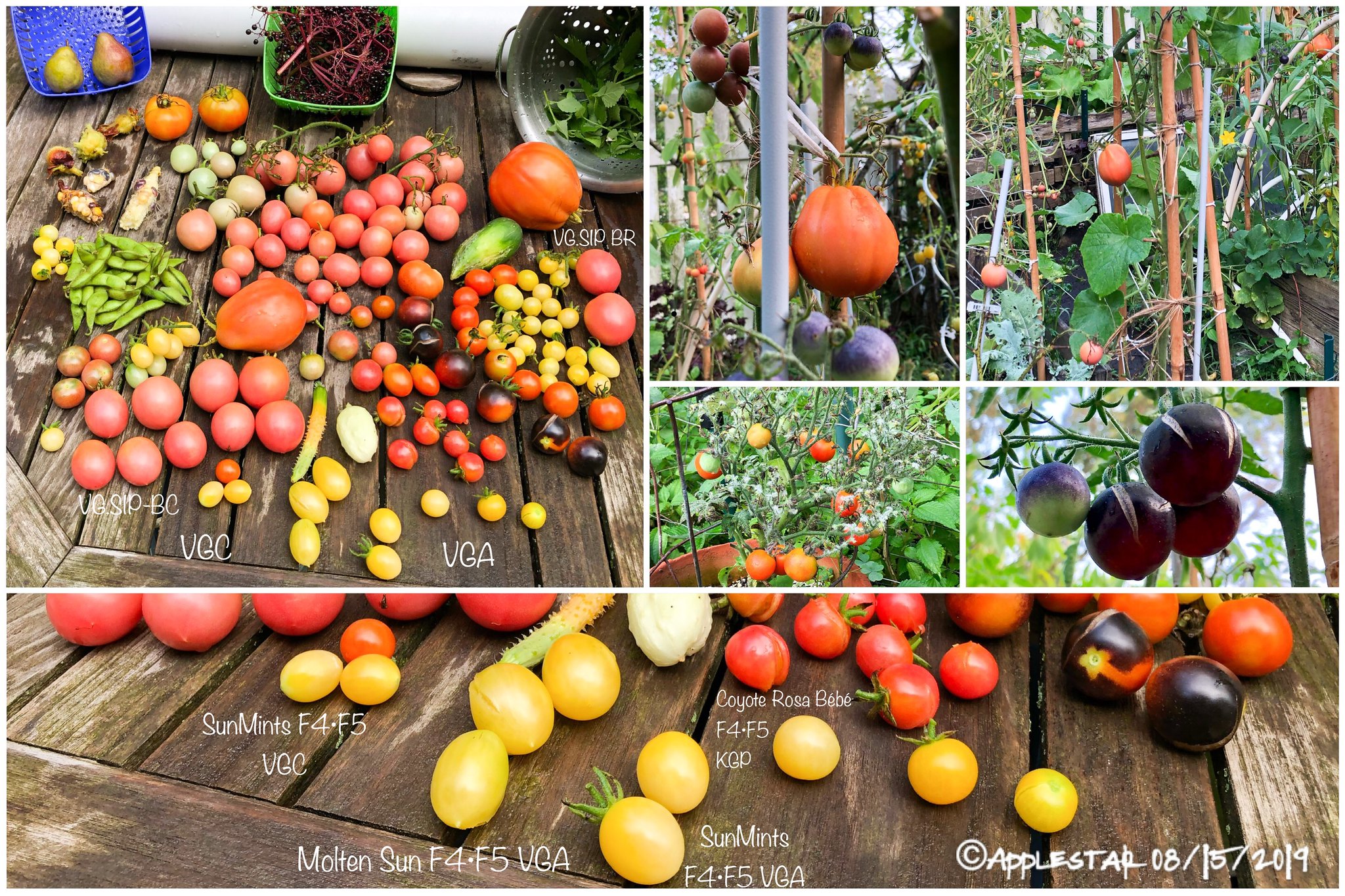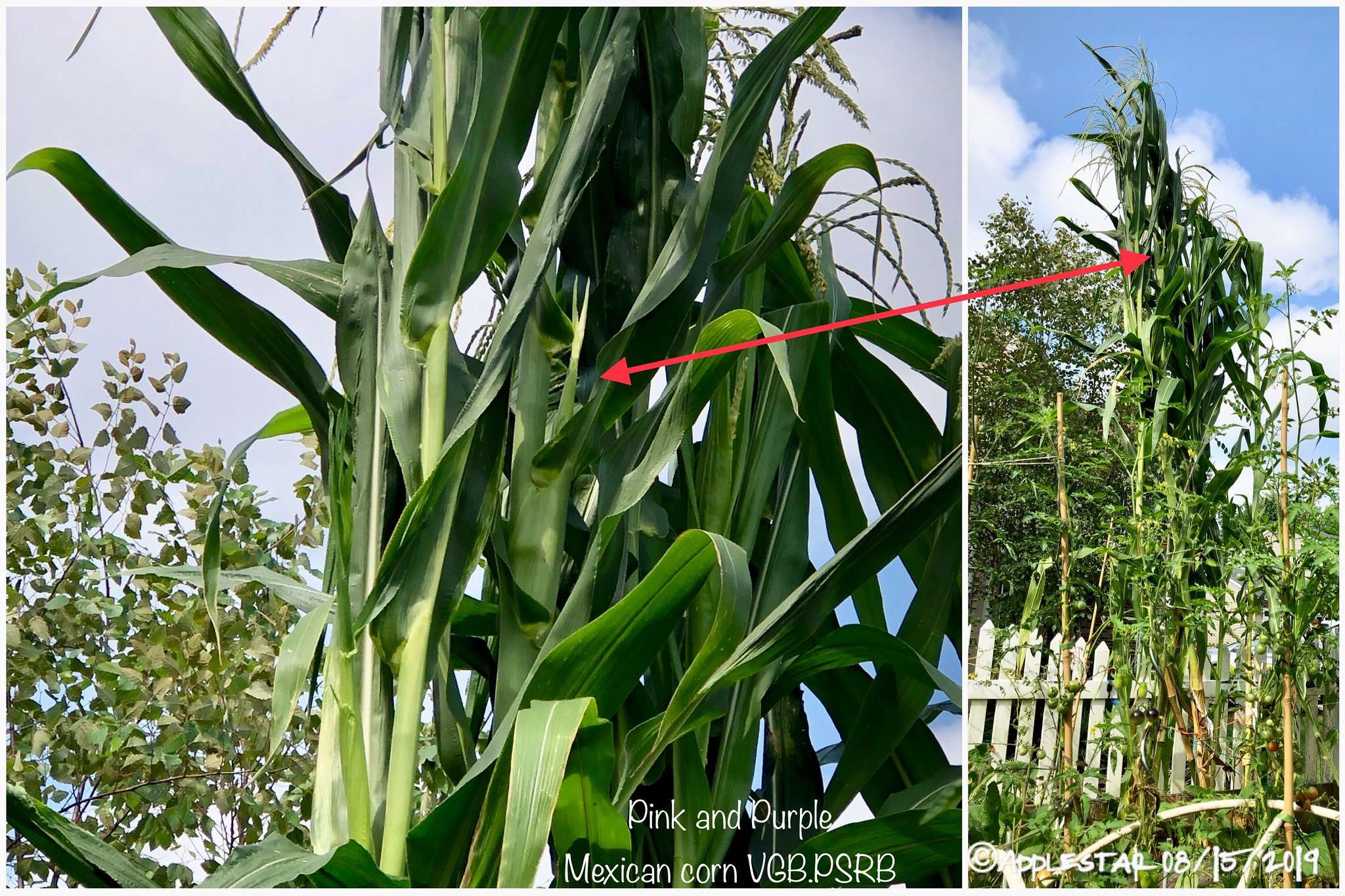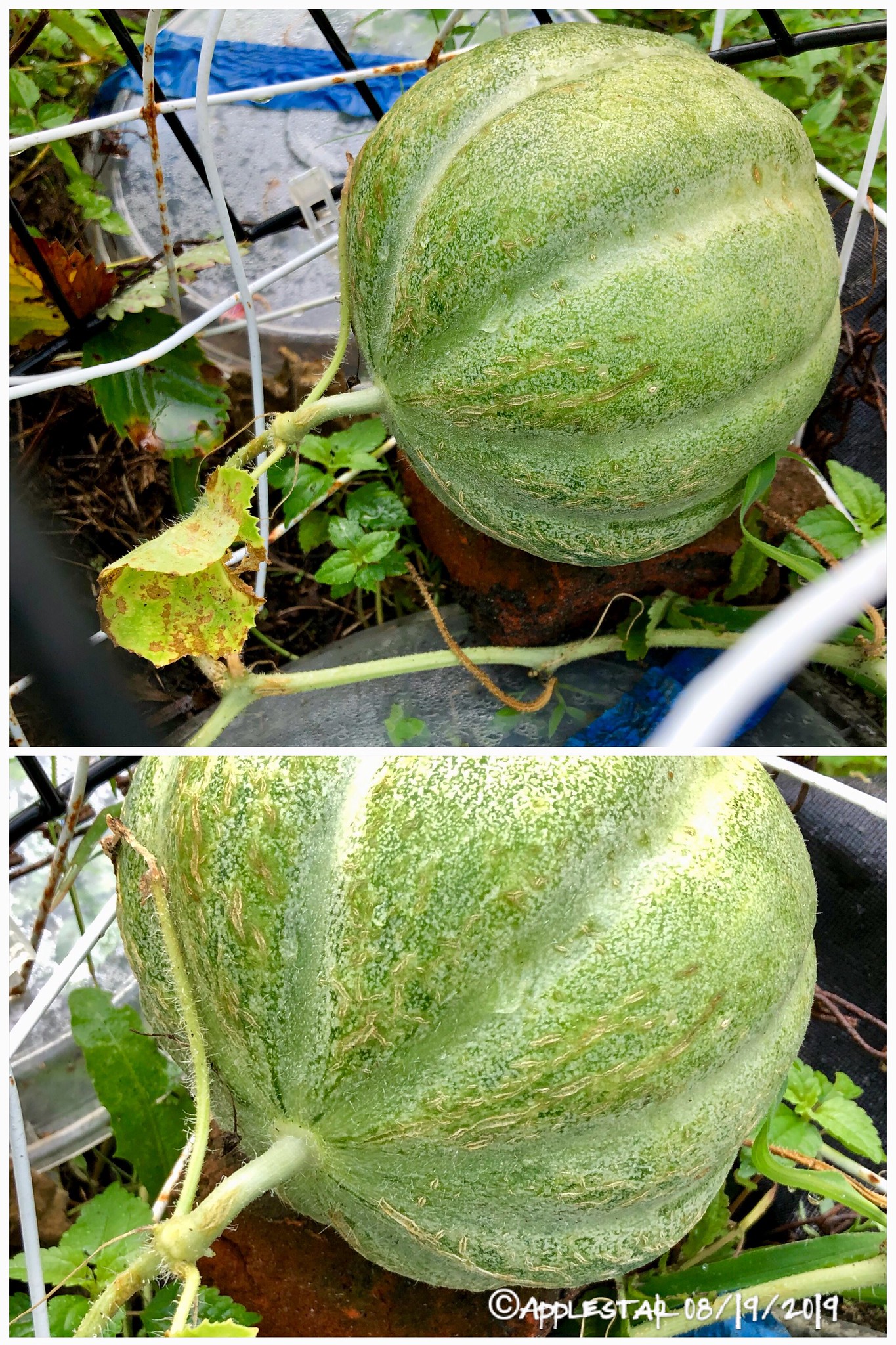
- applestar
- Mod
- Posts: 31057
- Joined: Thu May 01, 2008 7:21 pm
- Location: Zone 6, NJ (3/M)4/E ~ 10/M(11/B)
Re: Applestar’s 2019 Garden
Pink and Purple Mexican corn is starting to tassel atop 12 to 15 ft stalks.... 



- applestar
- Mod
- Posts: 31057
- Joined: Thu May 01, 2008 7:21 pm
- Location: Zone 6, NJ (3/M)4/E ~ 10/M(11/B)
Yes they are — I found pictures from 2017
Jun 02, 2017
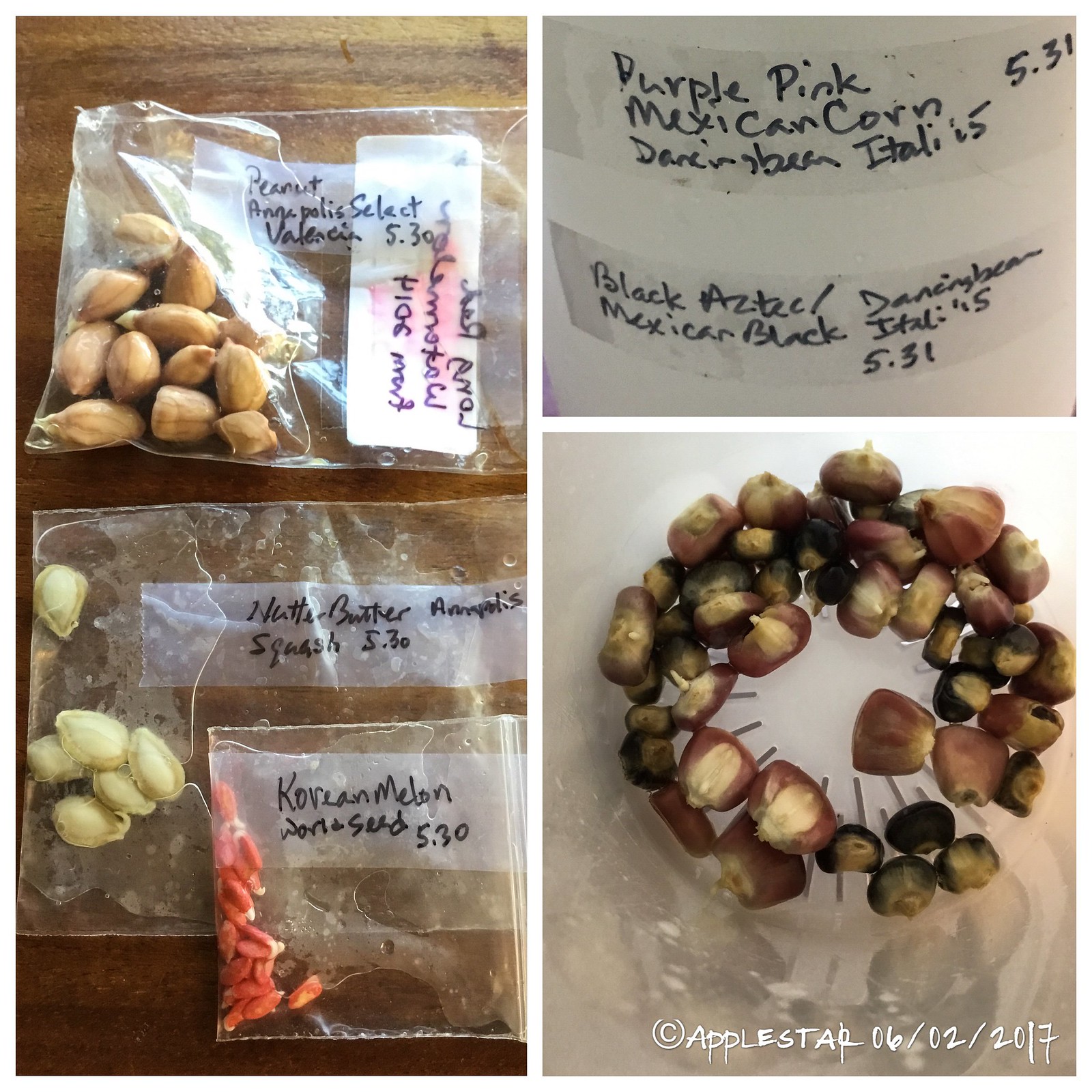
Jun 04, 2017
September 28, 2019
Subject: Applestar's 2017 Garden
October 29, 2019
Jun 02, 2017

Jun 04, 2017
Subject: Applestar's 2017 Gardenapplestar wrote:These are the giant purple and pink Mexican Corn and that is a 4 inch diameter ice cream tub lid.
September 28, 2019
applestar wrote:Finally saw one with silks growing today, but look at where. I tied a raffia string at 5ft height on the stalk.
CANNOT imagine walking in a whole field of this corn. Wow!
...chuckle with me if you remember my private joke about growing tall corn.
Subject: Applestar's 2017 Garden
October 29, 2019
applestar wrote:
...aaaaand... I have a fat corn cob growing on the Pink and Purple Mexican ! About 10-12 feet up
- TomatoNut95
- Super Green Thumb
- Posts: 2069
- Joined: Sun May 26, 2019 11:11 am
- Location: Texas Zone 8
Wow! Beautiful corn! Beautiful EVERYTHING you grow!  Sorry for not remembering where you got that Helsing Blue tomato. I haven't been well lately. However, I tasted my first Micro Tom fruit the other day, and my reaction was this: bleah! Bittery. Not super bitter, but bitter enough to make my taste buds curdle.
Sorry for not remembering where you got that Helsing Blue tomato. I haven't been well lately. However, I tasted my first Micro Tom fruit the other day, and my reaction was this: bleah! Bittery. Not super bitter, but bitter enough to make my taste buds curdle.
- applestar
- Mod
- Posts: 31057
- Joined: Thu May 01, 2008 7:21 pm
- Location: Zone 6, NJ (3/M)4/E ~ 10/M(11/B)
Subject: Learning • Practicing to Cross Breed Tomato Varieties
applestar wrote:I sorted through the Molten Sun F4/F5 and sister lines — harvested to date and now ripe, and discovered Molten Sun has a close branch sibling in the matte frosty/butter yellow Buttermints line — these are same size and shape as Buttermints, but like Molten Sun, are translucent and striped with faint pink blush. I’m calling them “Sun Mints F4/F5”
Harvested:
Ripe:
- it was really difficult to obtain the correct color under the fluorescent lights and I had to fiddle with photo editor. The result is a little more intense (darker yellow) than actual
[…]
* Molten Sun fruit is an extra elongated, sometimes pointed, grape cherry with potential to develop larger fruits as the vine matures. It has the intense tropical fruit front end and umami similar to its parent Coyote, with full-flavored middle and lingering acid tang, although when tasted in direct comparison, it is somewhat milder and not as in-your-face roughness.
* Sun Mints fruit is an elongated, sometimes pointed, small/currant cherry with wider shoulders than the narrower blossom end. It is similar in flavor as Molten Sun, but has more of a pure acid burn that lingers on — sort of like cinnamon flavored “mints”.
* I need to taste more samples to be sure, but it seems like blushed Buttermints and blushed Sun Mints with tiny streaks of pink flesh have extra sweetness to them.
- applestar
- Mod
- Posts: 31057
- Joined: Thu May 01, 2008 7:21 pm
- Location: Zone 6, NJ (3/M)4/E ~ 10/M(11/B)
I have a new curious looking mystery volunteer. It is small cherry sized, but not round or any other normal tomato shape. The first one picked was almost *bean* shaped. It is not round along the equator but is longitudinally flattened and cross-section would be oval in shape when cut along the equator. This is true of Sun Mints and also of Shimofuri. The color is red.

More recently harvested fruits are almost miniature piriform.... I really need to grow out the next generation and see what kind of traits develop.
...
Shimofuri F6 VG.sip-r



More recently harvested fruits are almost miniature piriform.... I really need to grow out the next generation and see what kind of traits develop.
...
Shimofuri F6 VG.sip-r


- applestar
- Mod
- Posts: 31057
- Joined: Thu May 01, 2008 7:21 pm
- Location: Zone 6, NJ (3/M)4/E ~ 10/M(11/B)
Ran into intensely tasty ones of those tiny red, currant size multiflora truss fruits while taste testing the fully ripe ones from the cherry tomato basket in the kitchen. This has me changing my mind about them — I believe they might be ‘Hundreds and Thousands” — a hanging basket variety that do not like heat and humidity. I might start some now and see if they might work as Winter Indoor Tomatoes for fall through the holidays. 


- applestar
- Mod
- Posts: 31057
- Joined: Thu May 01, 2008 7:21 pm
- Location: Zone 6, NJ (3/M)4/E ~ 10/M(11/B)
I took this picture because I wanted to make note of the Sun Mints at the bottom left and the Buttermints in the middle back under a leaf, plus the elongated white cherries that should be the matte white segregate. I remember framing the shot to include the cucumber halfway up the right side so as to remember to harvest it soon.

...it wasn’t until just a little while ago while looking through today’s photos that I realized I missed the cucumber hanging inside the pallet slats! ...sun’s set and it’s hot and I don’ feel up to going out now. DD told me “oh well, you can get it next time ... but doesn’t it already look overgrown/fat? Oh fooey!!
...sun’s set and it’s hot and I don’ feel up to going out now. DD told me “oh well, you can get it next time ... but doesn’t it already look overgrown/fat? Oh fooey!! 

...it wasn’t until just a little while ago while looking through today’s photos that I realized I missed the cucumber hanging inside the pallet slats!
-
SQWIB
- Greener Thumb
- Posts: 970
- Joined: Tue Feb 16, 2016 9:21 am
- Location: Zone 7A - Philadelphia, PA
Been following but haven't replied lately, everything is looking great and I don't know how the heck you keep track of everything.
I am not a cucumber fan but am growing them this year, just found out my daughter loves them. I do like to pull them before they get too big.
Same here with the heat, today was tomato and okra harvest, tomorrow or Thursday will be pepper and eggplant day.
Been freezing the tomatoes for sauce, which I said I wasn't going to do this year.
I just can't keep up with the tomatoes, it's unreal.
I am not a cucumber fan but am growing them this year, just found out my daughter loves them. I do like to pull them before they get too big.
Same here with the heat, today was tomato and okra harvest, tomorrow or Thursday will be pepper and eggplant day.
Been freezing the tomatoes for sauce, which I said I wasn't going to do this year.
I just can't keep up with the tomatoes, it's unreal.
- TomatoNut95
- Super Green Thumb
- Posts: 2069
- Joined: Sun May 26, 2019 11:11 am
- Location: Texas Zone 8
- applestar
- Mod
- Posts: 31057
- Joined: Thu May 01, 2008 7:21 pm
- Location: Zone 6, NJ (3/M)4/E ~ 10/M(11/B)
I don’t like the typical American cucumbers that have hard waxy skin and are watery and sometimes bitter. Variety makes all the difference.
Pickling cucumbers tend to taste better and have tender skin as long as you pick them early, I like the flavor and texture of long slender Japanese/Asian varieties but have once run into a variety that was inedibly bitter, so I am choosy. Armenian and Persian varieties are said to be very good, but I have trouble growing them — they are “hot house” varieties around here, I think, since they are closer to ...or are actually melons.
I’m starting to experiment growing parthenocarpic varieties, but those are basically hybrids and you can’t save seeds.
I keep growing from saved “Pickarow” seeds — originally seeds was a packet I picked up at Agway store. I can’t find this variety anymore. I’m also growing from saved “Shintokiwa” which may or may not have crossed with other varieties I was growing st the time.
Here’s that cucumber I missed harvesting yesterday (Saved Shintokiwa — looks correct). I had to run out for an errand earlier, stepped in the garden and harvested it. Looks like I got to it in time even though it is about 13” long and has started to bulge in the middle and is beginning to yellow at the stem end.

...if a cucumber is too overgrown, I like to peel, cut into big cubes and cook in soup, curry, pasta sauce, peanut sauce — goes well with all the meats chicken, pork, beef, also shrimp. If you overcook, they release water, melt and disappear - but the sauce gets added delicious flavor. I like them either way.
@SQWIB — are you talking about cutting off the blossom end of the fruit for pickling or for keeping in the fridge?
Pickling cucumbers tend to taste better and have tender skin as long as you pick them early, I like the flavor and texture of long slender Japanese/Asian varieties but have once run into a variety that was inedibly bitter, so I am choosy. Armenian and Persian varieties are said to be very good, but I have trouble growing them — they are “hot house” varieties around here, I think, since they are closer to ...or are actually melons.
I’m starting to experiment growing parthenocarpic varieties, but those are basically hybrids and you can’t save seeds.
I keep growing from saved “Pickarow” seeds — originally seeds was a packet I picked up at Agway store. I can’t find this variety anymore. I’m also growing from saved “Shintokiwa” which may or may not have crossed with other varieties I was growing st the time.
Here’s that cucumber I missed harvesting yesterday (Saved Shintokiwa — looks correct). I had to run out for an errand earlier, stepped in the garden and harvested it. Looks like I got to it in time even though it is about 13” long and has started to bulge in the middle and is beginning to yellow at the stem end.

...if a cucumber is too overgrown, I like to peel, cut into big cubes and cook in soup, curry, pasta sauce, peanut sauce — goes well with all the meats chicken, pork, beef, also shrimp. If you overcook, they release water, melt and disappear - but the sauce gets added delicious flavor. I like them either way.
@SQWIB — are you talking about cutting off the blossom end of the fruit for pickling or for keeping in the fridge?
- applestar
- Mod
- Posts: 31057
- Joined: Thu May 01, 2008 7:21 pm
- Location: Zone 6, NJ (3/M)4/E ~ 10/M(11/B)
Three of us ate the 10.9 oz NOT Steelhead today. Gorgeous big pink beefsteak. Green shoulders turned yellow (from the sun/heat?), but not as badly affected in the flesh as I feared.
First bite was a bottom 1/8 piece and initial thought was disappointment because at first bite as my front teeth closed, it tasted mild and lacked flavor, but even before that thought was completed, burst and explosion of umami tinged with sweetness spread in the mouth and continued on until the piece was swallowed, then a happy lingering tangy flavor without acid burn. Very very yummy!

...result...6 thumbs up! (DH thinks this would be really good on a hamburger and I agree — it has the assertive flavor profile to complement the sandwich without being drowned)
(DH thinks this would be really good on a hamburger and I agree — it has the assertive flavor profile to complement the sandwich without being drowned)
...I am wondering if this is a mislabeled Zena’s Gift since it was so early for an extra-large beefsteak, or maybe it’s an accidental bee cross with Steelhead as the mother. Bear Creek and Amy Sue were next to it in 2017 ... could a pink result from either of those combinations?
2017 SFH Tomato Garden

First bite was a bottom 1/8 piece and initial thought was disappointment because at first bite as my front teeth closed, it tasted mild and lacked flavor, but even before that thought was completed, burst and explosion of umami tinged with sweetness spread in the mouth and continued on until the piece was swallowed, then a happy lingering tangy flavor without acid burn. Very very yummy!

...result...6 thumbs up!
...I am wondering if this is a mislabeled Zena’s Gift since it was so early for an extra-large beefsteak, or maybe it’s an accidental bee cross with Steelhead as the mother. Bear Creek and Amy Sue were next to it in 2017 ... could a pink result from either of those combinations?
2017 SFH Tomato Garden

I grow mostly Japanese cucumbers too. I grow them to sell and the customers actually only want Japanese cucumbers and not the American ones. The heat and humidity does mean that certain cucumbers will do better than others. Suyo Long, Shiyo Kyuri, Tasty Green, and Jade do well. Suyo Long is parthenocarpic as well. I do like to grow one American type cucumber and that is Diva. Diva is parthenocarpic so it does not normally have seeds unless it gets pollinated anyway. It is non bitter as well. Most of the Chinese/Japanese cucumbers have a ridged skin and are not smooth like the American cucumbers, but once it is peeled, it does not matter. The other melon I like is the Armenian cucumber, which is not a real cucumber, but is heat resistant and can be eaten the same way.
- applestar
- Mod
- Posts: 31057
- Joined: Thu May 01, 2008 7:21 pm
- Location: Zone 6, NJ (3/M)4/E ~ 10/M(11/B)
... leaving more notes about that NOT Steelhead ...
...not a seed mix-up/migrated seedling either since Believe It or Not is a red

Based on the seed packet label, the seeds came from this fruit —
Subject: Applestar's 2017 Tomatoes (and peppers and eggplants)
Aug 14, 2017
August 22, 2017
...not a seed mix-up/migrated seedling either since Believe It or Not is a red

Based on the seed packet label, the seeds came from this fruit —
Subject: Applestar's 2017 Tomatoes (and peppers and eggplants)
Aug 14, 2017
Subject: Applestar's 2017 Tomatoes (and peppers and eggplants)applestar wrote:This one is a segregate of "Steelhead" -- a cross between a strain of Brandywine and Ananas Noir. I can't remember what filial generation it's at. The breeder named it for the colors which reminded him of the fish.
August 22, 2017
applestar wrote:This one was named "Steelhead" by the breeder after the freshwater fish. Those of you who fish them might recognize the coloring. It's a segregating off-shoot from 2015 seeds and the original line has been advanced so the one I have may or may not be true to type and I might not be correct in calling it by the given name. It was bred from a cross between a Brandywine he has been saving seeds and selecting for desirable traits and Ananas Noir. I harvested the fruit a week ago.
What GORGEOUS tomato! Definitely tri-color -- green, red, yellow. Yes, yes, I meant to eat this 2 days ago, but life intruded. So it did develop a (small) bad spot AFTER FULL 1 WEEK -- with scarring and mega-fused fruit like this, there are vulnerabilities -- but perfect fruit would have even better shelf life I think?
Surprisingly Sweet and Fresh are the two main descriptors that come to mind. Sometimes these qualities are lost when fruits are overripe. Started with Sweet front end -- tomato Sweet, nor sugary, and then not the heavy, salty deep flavor but Fresh and clean flavor with continuing Sweet and satisfying richness, then tangy lingering finish. I think this would please folks who prefer the brighter flavored tomatoes. My DD tomato taster said it was SWEET, NOT TOO STRONG, and VERY GOOD.
I would prefer to eat this one alone or in garden salads I think. Not too much other stuff to clutter up and mask the flavor.
- applestar
- Mod
- Posts: 31057
- Joined: Thu May 01, 2008 7:21 pm
- Location: Zone 6, NJ (3/M)4/E ~ 10/M(11/B)
TOP LEFT - VGA volunteer — definitely looking like a Korean melon/chamoe — it’s maybe 2 days to full ripe when the vertical white lines would be better defined. I think it slips from the vine, too, but will have to review.
TOP RIGHT - found another developing Kajari melon in the Spiral Garden

BOTTOM LEFT - I planted a started C.pepo plant under the mesh trellis between Latte Bicolor corn and Applestar’s #sweet# Medley corn, thinking it was a summer squash, and it stayed bushy and tried to set a round fruit, so I thought it was Ronde de Nice zucchini, but then it started to get SVB, which I tried to keep treating by spraying BT into the sawdust burrow hole...
— At some point, it fell over into the swale/path and then got beaten into the ground by a tropical storm remnant. I figured it was a lost cause and waited for it to start wilting, and tried to keep an eye out for immature fruits. But it was hard to get past the seriously vicious prickles, and it kept getting bigger until I realized it had started to run.
— At this point, I t’s taken over the entire swale/path — all 4-5 feet of the bed!
BOTTOM RIGHT ... And when I peered under all the leaves from all directions, mentally deriding it as being completely useless if no fruits, I found these two
** Can anyone tell me if this is Ronde de Nice? If it is, the bigger one is about baseball size — is it getting too big?
TOP RIGHT - found another developing Kajari melon in the Spiral Garden

BOTTOM LEFT - I planted a started C.pepo plant under the mesh trellis between Latte Bicolor corn and Applestar’s #sweet# Medley corn, thinking it was a summer squash, and it stayed bushy and tried to set a round fruit, so I thought it was Ronde de Nice zucchini, but then it started to get SVB, which I tried to keep treating by spraying BT into the sawdust burrow hole...
— At some point, it fell over into the swale/path and then got beaten into the ground by a tropical storm remnant. I figured it was a lost cause and waited for it to start wilting, and tried to keep an eye out for immature fruits. But it was hard to get past the seriously vicious prickles, and it kept getting bigger until I realized it had started to run.
— At this point, I t’s taken over the entire swale/path — all 4-5 feet of the bed!
BOTTOM RIGHT ... And when I peered under all the leaves from all directions, mentally deriding it as being completely useless if no fruits, I found these two
** Can anyone tell me if this is Ronde de Nice? If it is, the bigger one is about baseball size — is it getting too big?
- applestar
- Mod
- Posts: 31057
- Joined: Thu May 01, 2008 7:21 pm
- Location: Zone 6, NJ (3/M)4/E ~ 10/M(11/B)
This year’s corn is a bust — it seemed like I was going to be able to harvest some intact fully ripe corn for fall decoration and seed saving, then they came back last night 
I’m just going through the motions now. I’m just going through the motions now. I may still be able to save some viable seed corn after drying and sorting for unbroken/undamaged kernels, but it’s still discouraging.
 ...TOP-RIGHT — good side of the cobs
...TOP-RIGHT — good side of the cobs
...in desperation, I cut down these three stalks with nearly ripe cobs to dry as entire plants in the house before removing the cobs. Hopefully, this will work.
I’m just going through the motions now. I’m just going through the motions now. I may still be able to save some viable seed corn after drying and sorting for unbroken/undamaged kernels, but it’s still discouraging.
 ...TOP-RIGHT — good side of the cobs
...TOP-RIGHT — good side of the cobs...in desperation, I cut down these three stalks with nearly ripe cobs to dry as entire plants in the house before removing the cobs. Hopefully, this will work.
- applestar
- Mod
- Posts: 31057
- Joined: Thu May 01, 2008 7:21 pm
- Location: Zone 6, NJ (3/M)4/E ~ 10/M(11/B)
On a happier note, the tomatoes are starting to avalanche into the kitchen. Many of the near-ripe big fruits had split all the way to the gel today, which means they will have to be eaten without fully ripening. (I actually had some in my omelette this morning — I think the incompletely ripened ones are best when cooked.)
I offered some to my next door neighbor since he was watering his garden on the other side of the fence, and he brought me the red colander — too many split ones today to give him big ones, but I did give him a nice assortment of cherry tomatoes and a nearly perfect looking Japanese cucumber.

...more big ones are blushing, so hopefully I can offer him some nice slicers and sandwich tomatoes soon...
I offered some to my next door neighbor since he was watering his garden on the other side of the fence, and he brought me the red colander — too many split ones today to give him big ones, but I did give him a nice assortment of cherry tomatoes and a nearly perfect looking Japanese cucumber.

...more big ones are blushing, so hopefully I can offer him some nice slicers and sandwich tomatoes soon...
- applestar
- Mod
- Posts: 31057
- Joined: Thu May 01, 2008 7:21 pm
- Location: Zone 6, NJ (3/M)4/E ~ 10/M(11/B)
A volunteer from VGA transplanted to VGB.PSRB (Vegetable Garden bed B Pallet-sided Raised Bed) because it had antho stems and foliage as seedling. The plant and fruits have all the characteristics of “Allons-y Dr.X”. It would have been F5 if started from seeds (I did start from seeds in spring but they were among the seedling failures this year), so this could also be an earlier filial generation.
- Beefsteak shape with pronounced fluting (maybe more than previously observed)
- Exterior appearance is Yellow/Pink bicolor with dusting of antho on shoulders
- Dusting/sprinkling of antho on shoulders — this fruit had good sun exposure with added reflected sunlight from the white fence, so this is probably about maximum expression.
- Clear epi
- Note the subdermal antho in the flesh
- Yellow flesh with minor bi-color interior, but this fruit had heat-stress pithy core extending more than halfway down from the stem end, so bicolor flesh may be more extensive in unstressed fruit

- Due to healed radial cracking, the fruit suffered a severe split that was not noticed until today, and it was still not fully ripe when cut open, so it had the raw fresh tomato front end, but had sweet undeveloped umami middle and lingering tang that combined for a “refreshing” and good flavor profile. “It’s still good! (even if not quite ripe)”
...hopefully that next fruit will become available for full flavor review
— eta — That white stuff in the blackened wound is baking soda. I stuff the split with it when it extends to the gel to prevent/stop mold from growing as soon as the fruits are brought inside, and try to eat them up by the end of the day since this kind of wound won’t heal like skin-deep split, and will proceed to mold and rot within a day or two. If not possible to eat right away, then I cut out the bad parts and freeze for cooking within the next week or so (damaged fruits are not good enough for long term preserving)
- Beefsteak shape with pronounced fluting (maybe more than previously observed)
- Exterior appearance is Yellow/Pink bicolor with dusting of antho on shoulders
- Dusting/sprinkling of antho on shoulders — this fruit had good sun exposure with added reflected sunlight from the white fence, so this is probably about maximum expression.
- Clear epi
- Note the subdermal antho in the flesh
- Yellow flesh with minor bi-color interior, but this fruit had heat-stress pithy core extending more than halfway down from the stem end, so bicolor flesh may be more extensive in unstressed fruit

- Due to healed radial cracking, the fruit suffered a severe split that was not noticed until today, and it was still not fully ripe when cut open, so it had the raw fresh tomato front end, but had sweet undeveloped umami middle and lingering tang that combined for a “refreshing” and good flavor profile. “It’s still good! (even if not quite ripe)”
...hopefully that next fruit will become available for full flavor review
— eta — That white stuff in the blackened wound is baking soda. I stuff the split with it when it extends to the gel to prevent/stop mold from growing as soon as the fruits are brought inside, and try to eat them up by the end of the day since this kind of wound won’t heal like skin-deep split, and will proceed to mold and rot within a day or two. If not possible to eat right away, then I cut out the bad parts and freeze for cooking within the next week or so (damaged fruits are not good enough for long term preserving)
- applestar
- Mod
- Posts: 31057
- Joined: Thu May 01, 2008 7:21 pm
- Location: Zone 6, NJ (3/M)4/E ~ 10/M(11/B)
This is a volunteer growing on VGC front bamboo/string trellis. I was undecided whether it was Ernie’s Plump or Canestrino della Garfagnana (decided it was probably not Charlie Chaplin), but the cut open appearance and the dry hollow rather than meaty juicey seem to point more towards Canestrino della Garfagnana.
Also found a reference indicating Ernie’s Plump has jointless pedicels (fruit stems), and this plant definitely has jointed pedicels.

Also found a reference indicating Ernie’s Plump has jointless pedicels (fruit stems), and this plant definitely has jointed pedicels.

CANESTRINO DELLA GARFAGNANA
https://www.tomatofifou.com/boutique/to ... 258-detail
Variety native of the Province of Lucca in Tuscany, Italy. Same Canestrino di Lucca but rarer and better!
Canestrino Della Garfagnana
Aka Canestrino De Lucca
https://tomatprat.blogspot.com/2016/08/c ... gnana.html
Origin / History
This is an old heirloom tomato that has been grown for over 100 years in Garfagnana outside the city of Lucca, Italy.
- applestar
- Mod
- Posts: 31057
- Joined: Thu May 01, 2008 7:21 pm
- Location: Zone 6, NJ (3/M)4/E ~ 10/M(11/B)
Subject: Applestar’s 2019 Garden
I used to have a pretty accurate relational/mnemonic recall, but I guess I am getting older, and my memory is becoming Swiss cheese.... So I include near-by objects or background when framing the photos that help remember what, where, when. These extra/excess details are cropped out of the frame when assembling the collages later.
It’s always fun to see what’s been harvested at a glance, and the patio table slats give me a size reference. Sometimes I obsess and find myself (still) out in the hot sun arranging the “photo shoot”
I used to label the tomatoes in advance as I picked them, but now, I usually harvest in separate buckets and sometimes sub-containers, then group on the table by location. The “before harvest” photos gives me reference as well. Later, I make different collages of the photos and add labels for my own memory map/correlation, then use those photos as reference to label the fruits.
This way, when we taste them and/or save seeds, I know which one is which.
I don’t always post every collage or full set of photos, but here are most of the photos from today’s harvest.
I make use of the collages to group different views of the fruits, pre-harvest photos help to ID where they were grown and sometimes their plant characteristics. I can also pull up progress photos and identify the younger plant or green fruits based on current photo and make collages for specific variety or plant.
Sometimes, the relationship of the photos in the collages may or may not make obvious sense, but the process of making the collages etches the details in my memory better.
Today’s harvest arranged in quadrants and visually separated:

VGA, VGB, VGB.PSRB, VG.SIP-FR

VGC, VGD, VG.SIP-FL
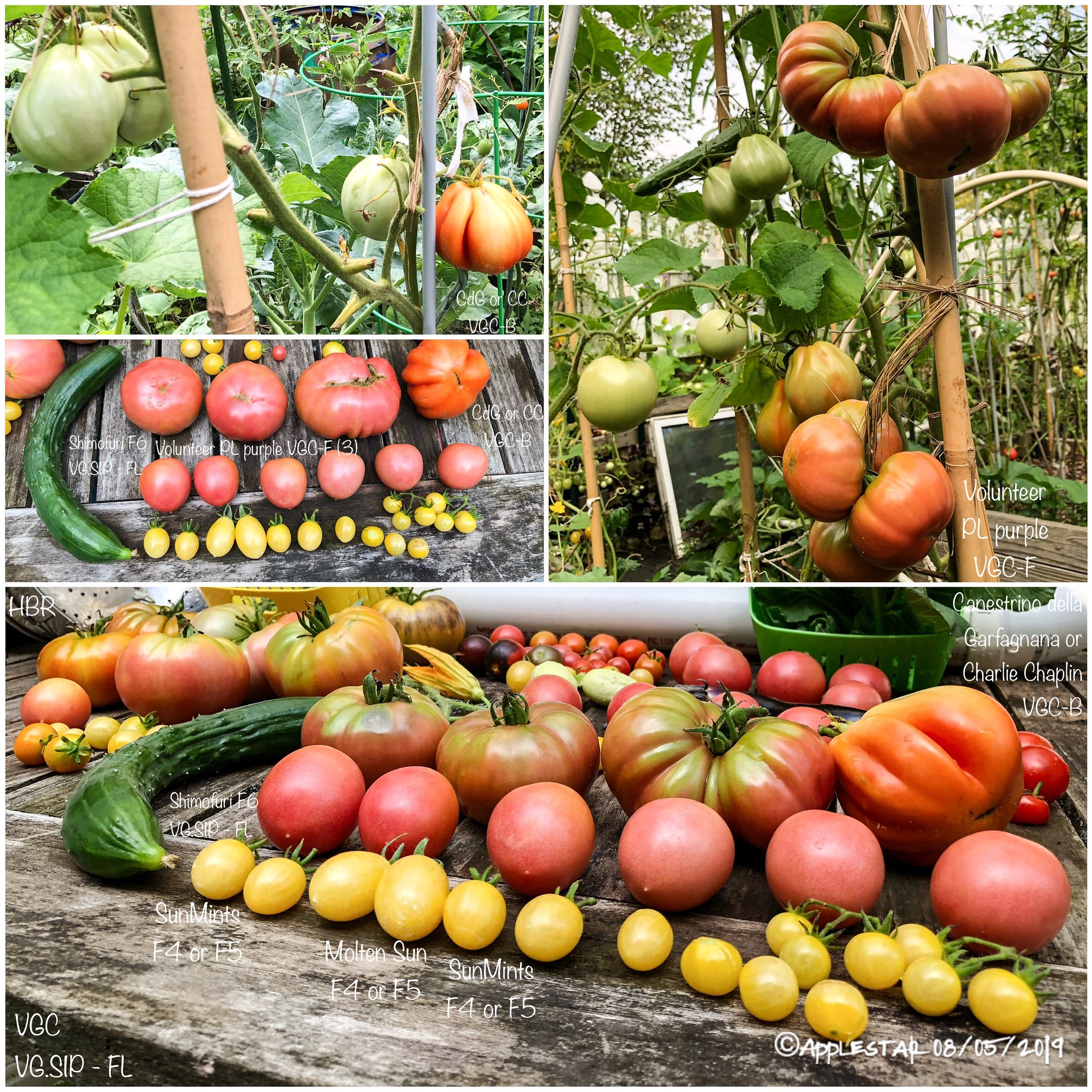
HaybaleRow (HBR)

Individually, and group-labeled tomatoes waiting to ripen or to be processed for cooking and/or seed saving

I noticed I didn’t reply to this question. One of the methods I use is to take lots of pictures and review them, make collages, and mark up with labels — I have a bunch of unlabeled pictures from previous years that are useless now because I have no idea what they represent, unless they had been posted in a thread somewhere with relevant commentary.SQWIB wrote:Been following but haven't replied lately, everything is looking great and I don't know how the heck you keep track of everything.
I used to have a pretty accurate relational/mnemonic recall, but I guess I am getting older, and my memory is becoming Swiss cheese.... So I include near-by objects or background when framing the photos that help remember what, where, when. These extra/excess details are cropped out of the frame when assembling the collages later.
It’s always fun to see what’s been harvested at a glance, and the patio table slats give me a size reference. Sometimes I obsess and find myself (still) out in the hot sun arranging the “photo shoot”
I used to label the tomatoes in advance as I picked them, but now, I usually harvest in separate buckets and sometimes sub-containers, then group on the table by location. The “before harvest” photos gives me reference as well. Later, I make different collages of the photos and add labels for my own memory map/correlation, then use those photos as reference to label the fruits.
This way, when we taste them and/or save seeds, I know which one is which.
I don’t always post every collage or full set of photos, but here are most of the photos from today’s harvest.
I make use of the collages to group different views of the fruits, pre-harvest photos help to ID where they were grown and sometimes their plant characteristics. I can also pull up progress photos and identify the younger plant or green fruits based on current photo and make collages for specific variety or plant.
Sometimes, the relationship of the photos in the collages may or may not make obvious sense, but the process of making the collages etches the details in my memory better.
Today’s harvest arranged in quadrants and visually separated:

VGA, VGB, VGB.PSRB, VG.SIP-FR

VGC, VGD, VG.SIP-FL

HaybaleRow (HBR)

Individually, and group-labeled tomatoes waiting to ripen or to be processed for cooking and/or seed saving

- applestar
- Mod
- Posts: 31057
- Joined: Thu May 01, 2008 7:21 pm
- Location: Zone 6, NJ (3/M)4/E ~ 10/M(11/B)

OK we are now questing for ID to the VGC volunteer growing on the south spiral tomato support. It’s a sturdy tree-like vine with huge spreading leaves and loaded with beefsteak shaped fruits that ripened to gorgeous perfect tomato red. Rich ketchup like fragrance from UNCUT fruit when ripe, meaty, juicy beefsteak-locules when cut open, and sweet front end, bursting with middle umami, and lingering tangy rich tomato flavor. Regretting not taking a picture of the ripe double we tasted, but there are more fruits coming.
Our favorite red in the past was Neves Azorean Red — but last I grew it was in 2014, so that was a while ago. I grew it in response to unbridled praise for the variety here on the HG forum (and I’ve been meaning to grow it again). Still, TomatoFest description about the “large central stem” caught my eye —
That plant really does have an unusually sturdy-looking thick stem, as well as wide-spreading thick leaves on strong leaf stems.Our TomatoFest organic tomato seeds produce indeterminate, regular-leaf tomato plants with a large central stem that have moderate to heavy yield of huge, 1-3 pound, deep-red, beefsteak tomatoes with terrific, bold, complex flavors.
BTW — It’s suffering from something that I don’t recognize, which causes these blackened dried up leaf edges. I’ve been cutting off an entire leaf once the condition seems to get worse, but the plant itself doesn’t seem to be affected by it? Let me know if you recognize the symptoms as something dire that I should be doing something else about?
- applestar
- Mod
- Posts: 31057
- Joined: Thu May 01, 2008 7:21 pm
- Location: Zone 6, NJ (3/M)4/E ~ 10/M(11/B)
We ate the Korean melon/Chamoe today since it was emitting an appetizing melon aroma this afternoon. It didn’t turn bright canary yellow with white longitudinal stripes, but I always suspected that the seeds I bought at the Korean supermarket, although simply labeled “Korean melon” was probably a F1 hybrid cultivar. So as long as this volunteer tasted sweet and yummy, which it did, I’m satisfied.
I would say the gel cavity wasn’t as juicy as the original, but the gel around the seeds and the placenta itself were sweet and tasty, not to be thrown away (which I had learned when I first researched it), and the flesh is “crunchy like an apple” not soft, and sweet and fruity/spicy, and tasty to the thin rind.
It naturally cuts into 10 wedges, so the children got 3 wedges and grownups got 2 wedges each. When I asked DD1 how she liked the melon, she said “Eh.” So I told her if she’s going to respond “Meh”, I’ll eat the LAST melon (wedge).” And she hastened to reply that she did NOT say “Meh” ... and that she didn’t know what I was expecting her to say, but they were good, sweet melon and it was HER “last melon”
DH made a point to say they were “REAL Good” ... and I haven’t heard from DD2 but she was busy alternately taking bites and spitting out the seeds. LOL
There’s another one, not quite as big so far, on the vine.
I would say the gel cavity wasn’t as juicy as the original, but the gel around the seeds and the placenta itself were sweet and tasty, not to be thrown away (which I had learned when I first researched it), and the flesh is “crunchy like an apple” not soft, and sweet and fruity/spicy, and tasty to the thin rind.
It naturally cuts into 10 wedges, so the children got 3 wedges and grownups got 2 wedges each. When I asked DD1 how she liked the melon, she said “Eh.” So I told her if she’s going to respond “Meh”, I’ll eat the LAST melon (wedge).” And she hastened to reply that she did NOT say “Meh” ... and that she didn’t know what I was expecting her to say, but they were good, sweet melon and it was HER “last melon”
DH made a point to say they were “REAL Good” ... and I haven’t heard from DD2 but she was busy alternately taking bites and spitting out the seeds. LOL
There’s another one, not quite as big so far, on the vine.
- applestar
- Mod
- Posts: 31057
- Joined: Thu May 01, 2008 7:21 pm
- Location: Zone 6, NJ (3/M)4/E ~ 10/M(11/B)
Pink and Purple Mexican Corn update — VGB.PSRB (Vegetable Gardenbed B - Pallet-sided Raised Bed)
We had another gusty storm a couple of nights ago, and I tied them to each other a little higher up at about 5 feet since they were starting to lean and spread apart. After this, I will have to get a ladder.
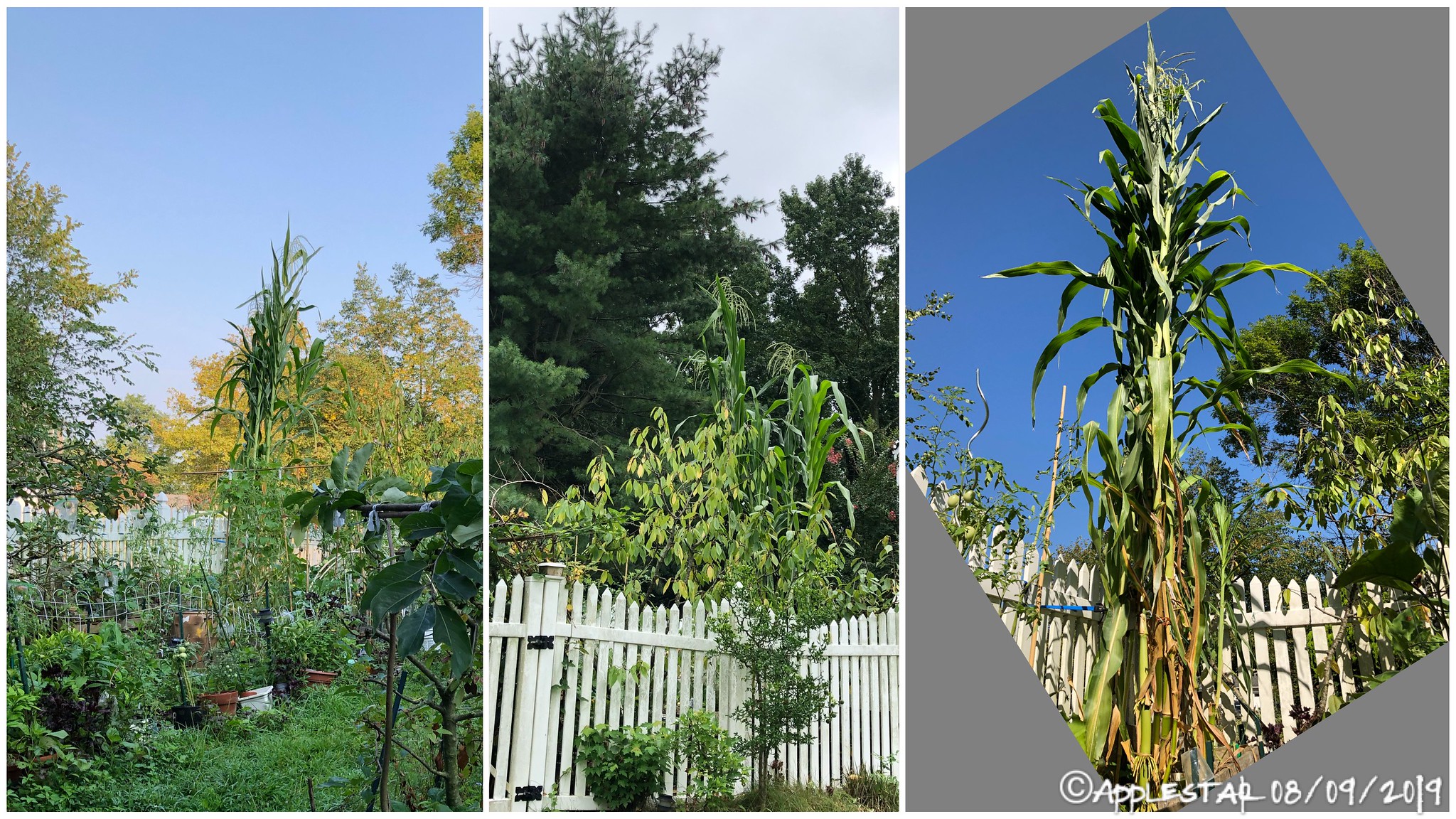
...my neighbor expressed “amazement” about these corn, but in case he was concerned that they would fall over into his side, I’ll try to do what I can to keep them together and upright. Using the bungee helps in a storm — wind can push them over but the bungee will support them without creating a kink in the stalk that may cause them to break and help them spring back. I may have to put another one up higher. Tying them to one another helps, too. Only other thing I can do is to keep them well watered.
I’m a bit worried that if I support them “too well” something big might climb up.... then it’s weight will bring the stalks down.
- One of the cucumber plants that were started at the left end of the VGB.PSRB decided to grow along the base of the corn and have managed to snake to the right in front of the corn all the way to the right edge of the bed, then when I turned it back, wrapped around to the back of the corn and up the skid panel lining the fence, then all the way back to the left end of the bed.
-- I no longer let vine crops climb up the corn — their foliage may interfere with pollination and their fruiting weight may bring the stalks down. And if the corn finishes before the vine crop, it’s impossible to remove the dying stalk that gets moldy in the fall rain.
- if you zoom in and look at the photo on the right, you might be able to see the aerial stem roots that normally might grow 6-8 inches up the stem growing almost 24 inches up the stem.
 They stand at about 3 times my height
They stand at about 3 times my height 
~~~~ CAN YOU PICTURE A FIELD OF THIS CORN? ~~~~~
....DEFINITELY worth growing, even if I don’t get filled cobs in harvest....
We had another gusty storm a couple of nights ago, and I tied them to each other a little higher up at about 5 feet since they were starting to lean and spread apart. After this, I will have to get a ladder.

...my neighbor expressed “amazement” about these corn, but in case he was concerned that they would fall over into his side, I’ll try to do what I can to keep them together and upright. Using the bungee helps in a storm — wind can push them over but the bungee will support them without creating a kink in the stalk that may cause them to break and help them spring back. I may have to put another one up higher. Tying them to one another helps, too. Only other thing I can do is to keep them well watered.
I’m a bit worried that if I support them “too well” something big might climb up.... then it’s weight will bring the stalks down.
- One of the cucumber plants that were started at the left end of the VGB.PSRB decided to grow along the base of the corn and have managed to snake to the right in front of the corn all the way to the right edge of the bed, then when I turned it back, wrapped around to the back of the corn and up the skid panel lining the fence, then all the way back to the left end of the bed.
-- I no longer let vine crops climb up the corn — their foliage may interfere with pollination and their fruiting weight may bring the stalks down. And if the corn finishes before the vine crop, it’s impossible to remove the dying stalk that gets moldy in the fall rain.
- if you zoom in and look at the photo on the right, you might be able to see the aerial stem roots that normally might grow 6-8 inches up the stem growing almost 24 inches up the stem.
...the article mentioned that if brace roots grow from more than two nodes, there is a problem and sugar is accumulating in the bottom of the stem, but I wonder if brace roots two feet up might not be the norm for such a tall plant? maybe I should have “hilled” more.... (25 inches worth?) Also, it’s possible that falling over in hurricane and tropical storm gale-force winds is normal for this corn and then they stand back up, rooting into the ground and bracing on those roots.Corn Roots - eXtension
https://articles.extension.org/pages/14064/corn-roots
[...] nodal root system, which means that the roots originate at one of the lower stem nodes (“joints”) of the plant. There are usually fives nodes below the soil surface, and the bulk of the root system grows from these nodes. The roots that grow from nodes above the soil surface are called “brace roots”, based on the observation that they appear to help brace the crop from falling over. Brace roots enter the soil some distance away from the stalk
~~~~ CAN YOU PICTURE A FIELD OF THIS CORN? ~~~~~
....DEFINITELY worth growing, even if I don’t get filled cobs in harvest....

- applestar
- Mod
- Posts: 31057
- Joined: Thu May 01, 2008 7:21 pm
- Location: Zone 6, NJ (3/M)4/E ~ 10/M(11/B)
Today is my gardening rest-day, but I’m on groundHOG watch at an upstairs window this morning. I suspect it raided my garden two days ago, and it came back THREE TIMES yesterday 
First time was within a one hour timeframe between when I finished gardening, came back inside and had breakfast. I had left a “surprise” over the wire fence surrounding the Brussels sprouts, where the beast had climbed to much on the leaves and upper stem (good thing I had already topped them and harvested the tender topmost leaves). The rock and rusty piece plant label wire had dropped — not sure but hope they hit it on its head! And the baker trays were askew or fallen.
I went out and “reset” those surprises and added a few more to other areas it had raided the day before. Then went upstairs with a cuppa, maybe a bathroom break, then wandered over to the window, and it was attacking the chicken wire fence surrounding the Kitchen Garden, trying to get at another planting of cabbages and Brussels sprouts. These are already pretty sorry looking from the moths and butterfly caterpillar predation, but no way I’m going to let the groundHOG have them when I haven’t decided what to do with them yet! I shook my water bottle/pebble rattle and banged on the window frame, and it ran off.
- I’m beginning to think it is watching and attacks as soon as the gardener/farmer goes inside, knowing no one will be coming back out for a while.
I checked frequently yesterday afternoon, and caught it one more time, halfway across the backyard, on its way to the Kichen Garden and the Patio.
This time, in addition to rattling at it from the window, I went downstairs and opened the door, and rattled with a rock in a big juice bottle which makes a deeper booming sound that should carry further and hopefully echo/bounce around the trees and structures.
...Sunrise was at 6:08am — no sign yet, but I think they tend to raid in the heat of the day...
First time was within a one hour timeframe between when I finished gardening, came back inside and had breakfast. I had left a “surprise” over the wire fence surrounding the Brussels sprouts, where the beast had climbed to much on the leaves and upper stem (good thing I had already topped them and harvested the tender topmost leaves). The rock and rusty piece plant label wire had dropped — not sure but hope they hit it on its head! And the baker trays were askew or fallen.
I went out and “reset” those surprises and added a few more to other areas it had raided the day before. Then went upstairs with a cuppa, maybe a bathroom break, then wandered over to the window, and it was attacking the chicken wire fence surrounding the Kitchen Garden, trying to get at another planting of cabbages and Brussels sprouts. These are already pretty sorry looking from the moths and butterfly caterpillar predation, but no way I’m going to let the groundHOG have them when I haven’t decided what to do with them yet! I shook my water bottle/pebble rattle and banged on the window frame, and it ran off.
- I’m beginning to think it is watching and attacks as soon as the gardener/farmer goes inside, knowing no one will be coming back out for a while.
I checked frequently yesterday afternoon, and caught it one more time, halfway across the backyard, on its way to the Kichen Garden and the Patio.
This time, in addition to rattling at it from the window, I went downstairs and opened the door, and rattled with a rock in a big juice bottle which makes a deeper booming sound that should carry further and hopefully echo/bounce around the trees and structures.
...Sunrise was at 6:08am — no sign yet, but I think they tend to raid in the heat of the day...
- applestar
- Mod
- Posts: 31057
- Joined: Thu May 01, 2008 7:21 pm
- Location: Zone 6, NJ (3/M)4/E ~ 10/M(11/B)
The groundHOG was here while I had been caught up in making some tomato sauce. My “surprise” had been sprung and the basket trays were on the ground — one pot shard was inside the Brussels sprouts cage on the SIP mix surface, and the other one was broken on the brick patio outside the cage. But I can’t find the egg sized rock. Maybe it fell directly on the beast and got flung away 
I put a bigger pot shard on top of the “surprise” in place of the rock, this time.
I put a bigger pot shard on top of the “surprise” in place of the rock, this time.
- applestar
- Mod
- Posts: 31057
- Joined: Thu May 01, 2008 7:21 pm
- Location: Zone 6, NJ (3/M)4/E ~ 10/M(11/B)
Set out more “surprises” for the groundHOG this morning. 
I’m finally harvesting ripe peppers! Doux Long d’Antibes turned fully yellow. This is an extra sweet variety.
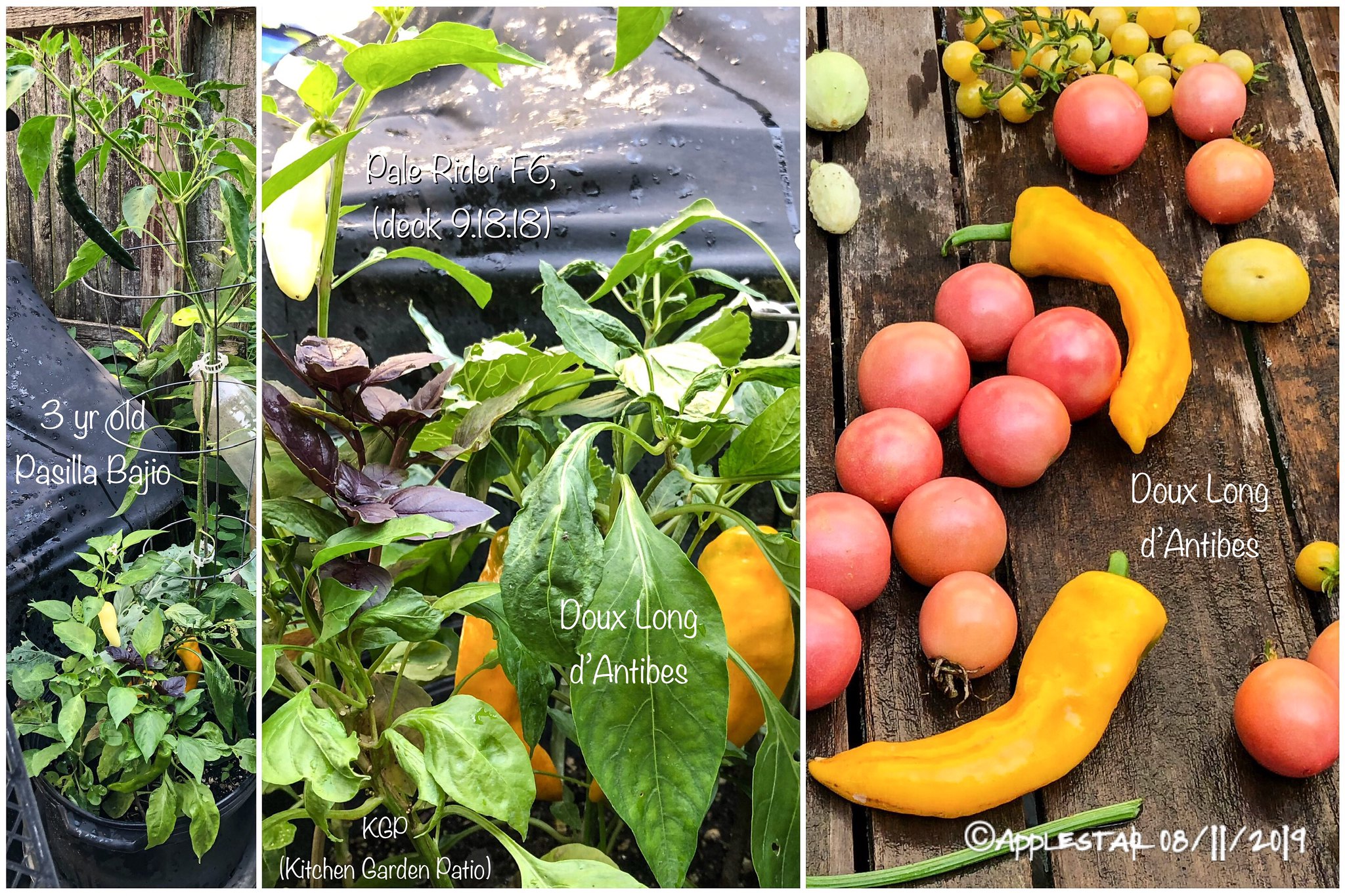
...in the same large pot in the Patio Kitchen Garden, there is a Pale Rider F6 — cream/white ripens to red — and a three year old Pasilla Bajio — very dark green ripens to dark chocolate. Purple leaves are Purple Petra Basil.
I’m finally harvesting ripe peppers! Doux Long d’Antibes turned fully yellow. This is an extra sweet variety.

...in the same large pot in the Patio Kitchen Garden, there is a Pale Rider F6 — cream/white ripens to red — and a three year old Pasilla Bajio — very dark green ripens to dark chocolate. Purple leaves are Purple Petra Basil.
- applestar
- Mod
- Posts: 31057
- Joined: Thu May 01, 2008 7:21 pm
- Location: Zone 6, NJ (3/M)4/E ~ 10/M(11/B)
Main tomatoes used for hot pack waterbath jars
- Cow’s Tit (HBR-Right) — 4.7 oz. Shoulders and upper 1/3 or so would not catch up to the blossom end as the fruits ripened. Waited as long as I could. ...less bright red flesh inside than the VGC volunteer Very good umami flavor, dry/paste and stingy with seeds.
- VGC front right volunteer piriform with jointed pedicel (Canestrino della Garfagnana or Charlie Chaplin — less pleated than VGC back right... looks similar to VGA volunteer — 8.1 oz. Intense red and intense sweet/umami flavor. Very good.
- Pennheart (HBR) — 4.1 oz. — this was a bit watery but did have good flavor profile.
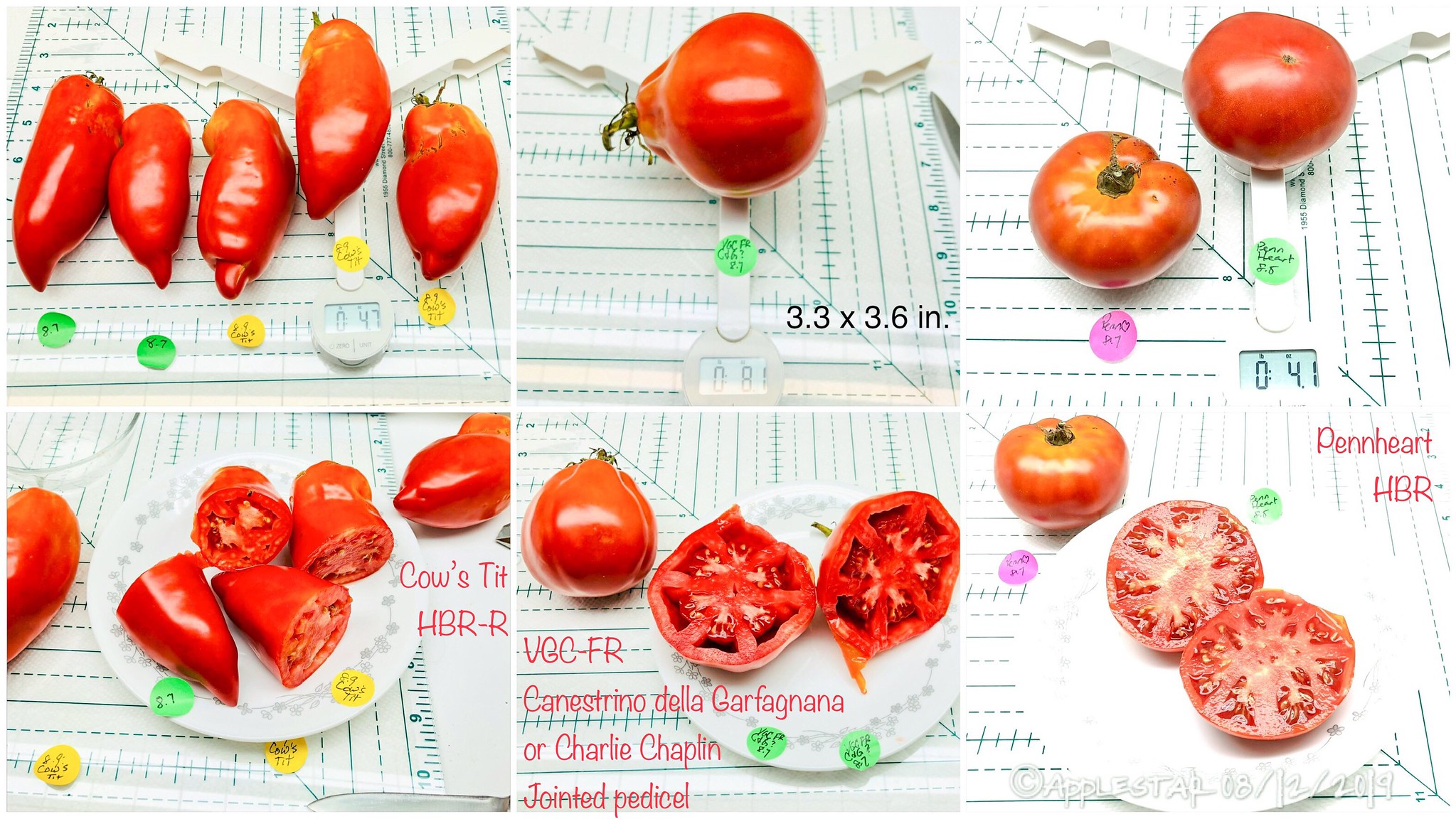
— also used the Shimofuri plant VG.SIP-FL fruits which were bland and less flavorful when eaten fresh, as well as a few others.
... harvested more today
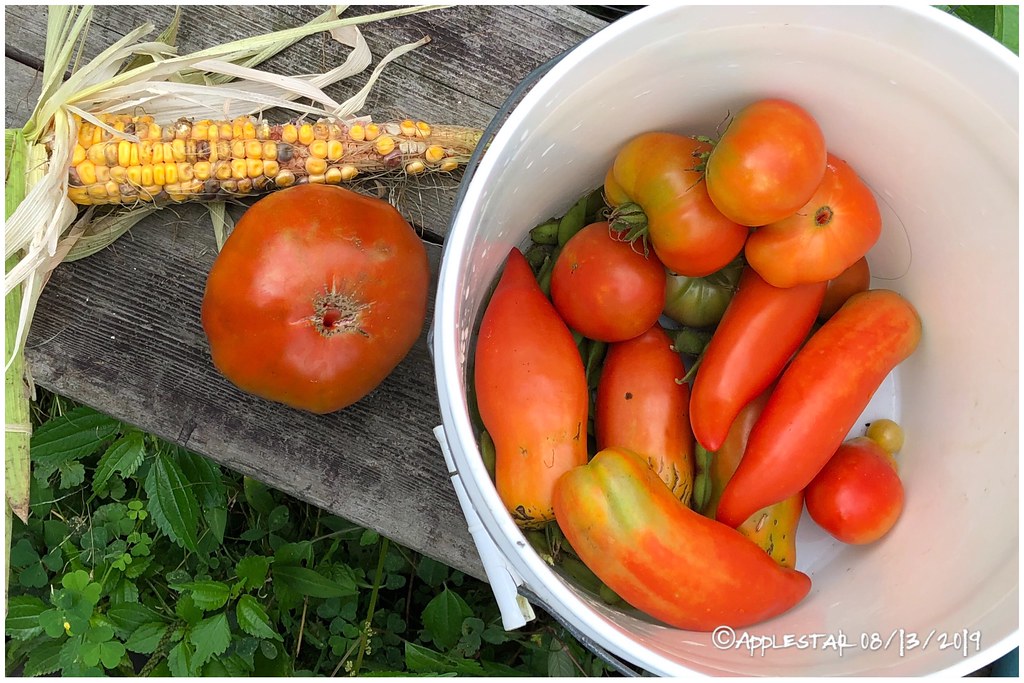

— Cow’s Tit (HBR-L) would not subscribe to its nomenclature and presented with longer narrower horn-shaped fruits — they look more like red peppers
...first NOT Opalka ripened. They are very productive but wrong size/shape fruits. Don’t they look kind of like San Marzano? May be mislabeled seed packet.
...have to weigh and measure that NOT Homer Fike’s Yellow Oxheart — it might be the biggest tomato this season.
- Cow’s Tit (HBR-Right) — 4.7 oz. Shoulders and upper 1/3 or so would not catch up to the blossom end as the fruits ripened. Waited as long as I could. ...less bright red flesh inside than the VGC volunteer Very good umami flavor, dry/paste and stingy with seeds.
- VGC front right volunteer piriform with jointed pedicel (Canestrino della Garfagnana or Charlie Chaplin — less pleated than VGC back right... looks similar to VGA volunteer — 8.1 oz. Intense red and intense sweet/umami flavor. Very good.
- Pennheart (HBR) — 4.1 oz. — this was a bit watery but did have good flavor profile.

— also used the Shimofuri plant VG.SIP-FL fruits which were bland and less flavorful when eaten fresh, as well as a few others.
... harvested more today


— Cow’s Tit (HBR-L) would not subscribe to its nomenclature and presented with longer narrower horn-shaped fruits — they look more like red peppers
...first NOT Opalka ripened. They are very productive but wrong size/shape fruits. Don’t they look kind of like San Marzano? May be mislabeled seed packet.
...have to weigh and measure that NOT Homer Fike’s Yellow Oxheart — it might be the biggest tomato this season.
- applestar
- Mod
- Posts: 31057
- Joined: Thu May 01, 2008 7:21 pm
- Location: Zone 6, NJ (3/M)4/E ~ 10/M(11/B)
Spiral Garden Melons update — 7 are now hanging in slings, and one on the ground somewhat protected with a wire hanging basket — I pre-germinated mixed seeds of these new varieties (and some old seeds) and planted what sprouted.
Baker Creek -
- Collective Farm Woman Melon
- Ha'ogen Melon
- Jubilee Watermelon
- Kajari Melon
Fedco
- Montreal Market

- watermelons are likely Jubilee
- 2 small green and white striped melons must be Kajari (there’s another one growing in VGC)
- even toned, smooth round one is probably Collective Farm Woman
- Not sure how to tell the difference between Ha’ogen and Montreal Market.... I think Ha’ogen is not netted and Montreal Market is netted? So maybe the one under the wire hanging basket is Ha’ogen?
...anyone grow these varieties before? Can you tell?
Baker Creek -
- Collective Farm Woman Melon
- Ha'ogen Melon
- Jubilee Watermelon
- Kajari Melon
Fedco
- Montreal Market

- watermelons are likely Jubilee
- 2 small green and white striped melons must be Kajari (there’s another one growing in VGC)
- even toned, smooth round one is probably Collective Farm Woman
- Not sure how to tell the difference between Ha’ogen and Montreal Market.... I think Ha’ogen is not netted and Montreal Market is netted? So maybe the one under the wire hanging basket is Ha’ogen?
...anyone grow these varieties before? Can you tell?
- TomatoNut95
- Super Green Thumb
- Posts: 2069
- Joined: Sun May 26, 2019 11:11 am
- Location: Texas Zone 8
- applestar
- Mod
- Posts: 31057
- Joined: Thu May 01, 2008 7:21 pm
- Location: Zone 6, NJ (3/M)4/E ~ 10/M(11/B)
It’s a struggle to grow them here primarily because it doesn’t get hot enough and it doesn’t rain enough in the critical beginning/fruiting growth period, 2ndarily I think because I don’t feed them enough.
I’ve finally improved my methods to manage maybe 1/2 dozen FRUITS each year now. But they are still not reaching their potential sizes, let alone numbers. So far, Korean melon has been the only variety that I could say I’ve succeeded in growing... but this year, I didn’t plant any ... except one volunteer happened to grow and give me two fruits (they are supposed to be able to produce 8-12 fruits per vine.)
...I think I’ve tentatively identified this year’s fruits — I labeled the same photo collage from before... (there are maybe another 4-6 baby fruits on the vines, but it’s doubtful that they will grow to maturity,)
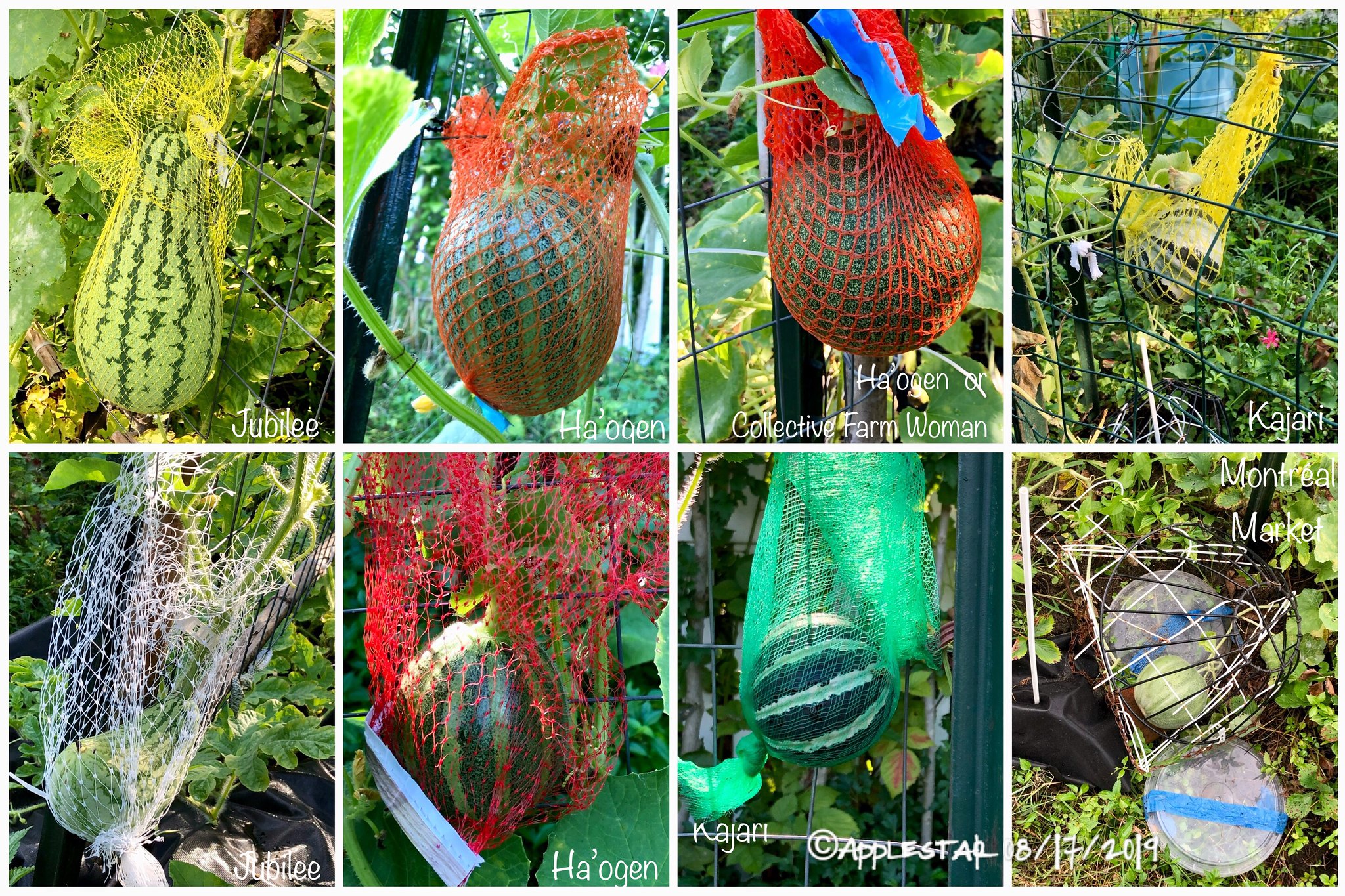
I’ve finally improved my methods to manage maybe 1/2 dozen FRUITS each year now. But they are still not reaching their potential sizes, let alone numbers. So far, Korean melon has been the only variety that I could say I’ve succeeded in growing... but this year, I didn’t plant any ... except one volunteer happened to grow and give me two fruits (they are supposed to be able to produce 8-12 fruits per vine.)
...I think I’ve tentatively identified this year’s fruits — I labeled the same photo collage from before... (there are maybe another 4-6 baby fruits on the vines, but it’s doubtful that they will grow to maturity,)


